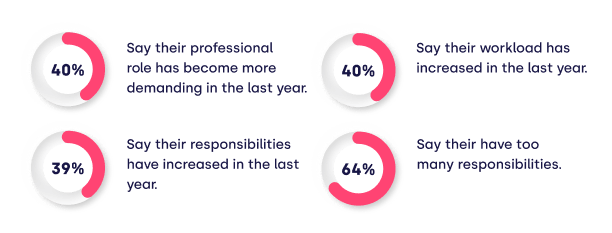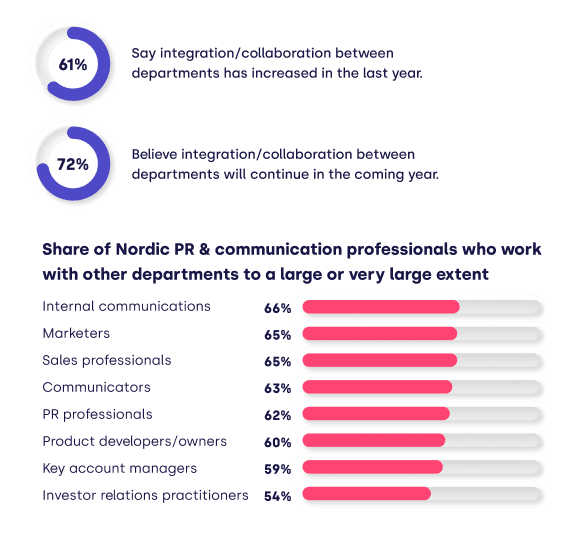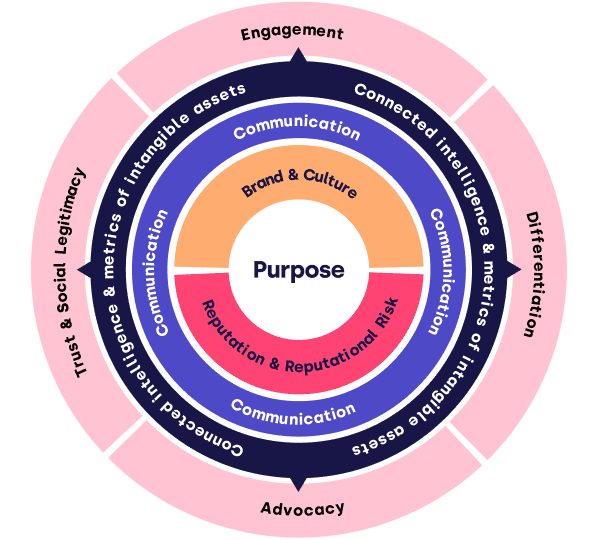PR Report 2022 – Trends, challenges, and opportunities

Working in the communication industry is becoming more challenging and demanding. Nordic PR and communication professionals are faced with more responsibilities and heavier workloads as well as increased competition and a more complex media landscape.
As a PR solution and all-in-one public relations platform, Mynewsdesk wants to offer a helping hand to PR and communication professionals, and be a driving force in the development of the communications industry.
This blog post is a summary of a larger PR report that we have created through thorough trend analysis, expert interviews, and a digital survey among Nordic PR and communication professionals. We have identified five key areas that are critical to anyone in the business to understand, relate to, or act upon, to stay relevant in the industry:
- Redefined roles
- Converging comms
- Content chaos
- Measurement matters
- Purpose power
Ultimately, we hope that these findings will work as a spark of inspiration and a source of pride for us working with PR and communication.
Redefined Roles
When asking Nordic PR and communication professionals’ how they experience that their roles have, and will continue to change, these are the three main takeaways:
1. PR and communication roles are more challenging than ever before
The results clearly show that work-life is becoming more challenging and demanding and that both their workload and responsibilities have increased.

2. Roles will become more specialized and generalized
66 % believe their role will become more specialized in the future
58 % believe that in five years, all roles related to communications and marketing (PR, communications, marketing, sales, and customer relations) will have blended into one
65 % would rather become a specialist than a generalist
3. Upskilling is required to stay relevant
70 % believe constantly developing your skills will be crucial to stay relevant in the PR and communication industry
72 % would like to develop their skills in one or several areas
If these results feel a bit overwhelming, it’s probably because that’s how a lot of PR and communication professionals are feeling – overwhelmed. As demands have increased, many professionals feel like they have too much to do, and that they need to be both generalists and specialists. To get a healthy work-life balance, prioritizing will be extremely important, as well as outsourcing when needed. Even though many of us are eager to do everything at once, it’s simply not possible.
Although, with all this in mind, it comes as no surprise that continuously upskilling in one or several areas will be needed to succeed in the industry in the long run. Nordic PR and communication professionals themselves believe that the top three most important skills in the future will be strategic thinking, business skills, and leadership skills. When it comes to the top three most important attributes, they believe it will be creativity, problem-solving, and flexibility.
Converging Comms
Gone are the days of clearly separating departments from one another – instead, convergence is here to stay. This trend has been seen in many industries, and PR and communications are no exception. Let’s dig deeper into what this industry’s professionals have to say about it:
1. Convergence is already increasing – and will continue to do so
As the industry is becoming increasingly complex, it’s more important than ever to build a strong team and brand. This helps create brand consistency and cohesive customer experiences, which are both more important than ever to cut through the noise.
When examining which Nordic PR & communication professionals work with other departments to a large or very large extent, these were the results:

2. There are several benefits of convergence…
Collaboration marketing, communication, and PR professionals are widespread, but so is a collaboration with other departments. If your PR and communication functions are not already integrating with the rest of the company, it’s about time! Many PR and communication professionals see several benefits, especially when it comes to areas such as productivity, efficiency, and knowledge exchange.
Top 3 effects of increased integration/collaboration:
- Increased productivity: 60 %
- Increased efficiency: 60 %
- Knowledge exchange: 58 %
73 % believe increased collaboration is important for more efficient and innovative PR/communication work.
3. … but sometimes, department division is required
Although collaboration comes with many benefits, there are a few things to keep in mind. Project management and clear leadership are crucial to make sure everyone knows who’s doing what, what they should be doing, and what the goals are.
61 % believe their department works best as a separate function
35 % believe increased collaboration between departments has decreased their role clarity.

Content is king, but many Nordic PR and communication professionals experience difficulties when it comes to delivering engaging, trustworthy, and high-quality content. How come?
1. The importance of content is increasing
More businesses are seeing the benefits of content. Six of ten Nordic PR and communication professionals say their organization views content as a core business strategy. Almost three-quarters of businesses have a content strategy, and marketing budgets spent on content are increasing globally.
60 % say their organization views content as a core business strategy
74 % have a content strategy
2. The main content challenge: too much is too bad
Naturally, as more companies produce and distribute more content, reaching out to one’s audience has become harder. The main challenge is to create trustworthy content. The general opinion is that not only is the quantity of content on the market too high, but the quality of it is also too low. Research confirms that this perception is shared with consumers.
26 % thinks the biggest content challenge is creating credible/trustworthy content
52 % believe there is too much content created today
46 % say the quality of most of the content produced by their organization is poor
3. The consequences of content chaos – and the solutions
Consumers today are more critical and indifferent toward brands. Studies show that according to customers, more than half of brands are seen as not trustworthy and that three-quarters of brands could easily be replaced.
Given the competition and challenges brands withstand, here are some of the solutions stated by Nordic PR and communication professionals:
- It is vital for brands to build trust and create content that differentiates them from competitors. Going the extra mile and thinking outside of the box is a must for content creation today.
- Brands state that better alignment between departments is needed in order to create better content.
- Larger budget (as always).
Psst! For six professional tips on how to produce differentiating, trustworthy content, download the report!
4. What will the future of content look like?
When looking at what types of content Nordic PR and communication professionals will focus on in the future, this is what’s on their agendas:
Top five content types that Nordic PR & communication professionals will focus more on in the coming year
- Informative/educational : 39 %
- Inspirational: 38 %
- Humorous/playful/feel good: 35 %
- Reflecting company values: 35 %
- Taking a stand on social issues: 34 %
Most prioritized channels for the coming year
- Social media posts: 43 %
- Videos: 38 %
- E-mails/newsletters: 34 %
- Webinars: 33 %
- Events: 33 %

While Nordic PR and communication professionals are feeling the pressure to measure, it’s clear that it’s a subject approached with both scepticism and fear. Why?
1. Increasing pressure to measure
The communication industry is becoming more result-oriented, and according to experts, the trend will only intensify. The companies that are going to win are the ones who are using data instead of guessing.
63 % believe measuring impact (e.g. on brand awareness, engagement, retention, sales) of PR/communication efforts is crucial in today’s PR & communication landscape
61 % believe measuring impact is key to increasing the status of one’s profession in the organization
67 % believe measurement and evaluation are crucial to ensure continuous improvement of PR & communication efforts
2. Lacking knowledge and tools to measure
Despite measurement’s importance, our study reveals widespread fear and skepticism towards it, along with a general lack of tools and knowledge to measure properly.
54 % are worried that if they start using metrics it will become evident that PR/communication efforts don’t have enough impact (e.g. on brand awareness, engagement, retention, sales)
56 % believe measuring impact doesn’t give a deeper understanding or say anything about engagement
64 % believe it’s more important to focus on the organization’s vision than being fixated on metrics
Obstacles for measuring communication efforts
- Lack of tools: 27 %
- Lack of skills: 27 %
- Lack of understanding what to measure and why among colleagues: 25 %
So what’s the solution to this scepticism and fear? To establish a measurement culture. This way, everyone in the company understands why it is important to measure, and what to measure. Measurement needs to be seen as a core practice to manage communications, and a way to create value for the organization.

Purpose power
PR and communications play a central role in societal issues – both positively and negatively. As Sir David Attenborough declared once “Saving our planet is now a communications challenge”.
In these times of content chaos and scarce trust between brands and consumers; how can PR and communication professionals navigate around sustainability effectively and credibly?
1. Purpose as a starting point for communication
To act purposefully as a brand today is increasingly important for PR and communications.
At the same time as purpose is becoming a more important factor in decision-making for consumers, there is an increasing scepticism towards sustainability communication nowadays. Edelman’s global trust barometer showed that more than half of consumers believe too many brands are using societal issues as a marketing ploy. To summarize, sustainability communication is a complex subject, yet companies prioritize it highly.
72 % say that communication connected to corporate social responsibility (CSR) is highly prioritized in their organization today.
20 % report dealing with sustainable development and social responsibility issues as one of the main externally related challenges.
2. Misleading and false sustainability communication
Despite stronger directions and regulations, more and more reports show that misleading and false sustainability communication is still widespread in the industry.
A study by Changing Markets Foundation revealed that six in ten environmental claims made by UK and European fashion brands were classed as unsubstantiated or potentially misleading. Further, many arguments used in marketing are vague and lack detailed information, making it difficult or even impossible for consumers to understand why a product is, for example, climate-friendly.
When asking Nordic PR and communication professionals what the challenges with communicating social and environmental issues are more specifically, it’s evident that there is a knowledge gap – both on the issues in general and when it comes to understanding rules and laws.
Another challenge Nordic PR and communication professionals face when it comes to communicating social and environmental issues, is knowing what level of complexity and tonality is the most effective and understandable. Some experts argue that sustainability communication is too simplified, whereas others think the arguments and information are too complex for a general consumer to understand.
Two other challenges when it comes to communicating social and environmental issues are the worries of being accused of greenwashing and not taking enough action on the issue.
Main challenges for Nordic PR & communication professionals when it comes to communicating social and environmental sustainability issues
- Understanding rules and laws: 29 %
- Knowing what level of complexity is most efficient: 29 %
- General lack of knowledge on the issues: 28 %
- The organization don’t do enough about issues to talk about them in a trustworthy way: 28 %
- Not prioritized in the organization: 24 %
- Lack of framework: 24 %
- Fear of being criticized or accused of greenwashing: 23 %
Recognize yourself in these challenges? Download the full report to gain five expert tips on how to build credible sustainability communication.
3. The future of purposeful communication
To succeed with communicating sustainability, the first step is to get comfortable in communicating progress over perfection. Doing little is better than doing nothing – both for societal causes and for pleasing today’s consumers.
Telling the world about your ambitions and inviting them on the journey is better than not saying anything out of fear of greenwashing. The key is to be transparent about both ambition and weaknesses. Putting brutal honesty first is also applicable in relation to the organization: daring to take a more independent and challenging role and make social issues the starting point.
Summary
Redefined roles
The workload and work pressure are higher than ever. To handle this, PR and communication professionals need to become better at prioritizing and focusing on what is important.
Converging comms
As the industry is becoming increasingly complex, it’s more important than ever to build a strong team and brand. A majority of PR and communications professionals believe increased collaboration is important for more efficient and innovative work.
Content chaos
Content is becoming more important and popular, and therefore, the need to counteract the ruling content chaos of today is crucial. Quality over quantity, always.
Measurement matters
Lack of knowledge, as well as widespread misconceptions and fears around measurement, are hindering factors for development and creating value.
Purpose power
Misleading and false sustainability communication has increased the need for companies to be honest and transparent in their communication. Doing little is better than doing nothing at all in fear of opposition.
All in all
Challenges aside, if there is one thing that this report shows, it is that the opportunities for PR and communication to make a real impact are bigger and more needed than ever. Success comes to those who dare to be honest, who face their fears, who think outside the box, and those who go that extra mile!